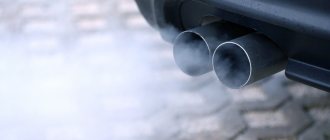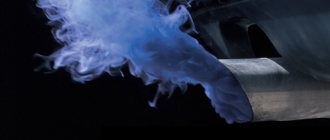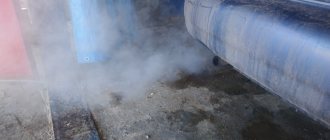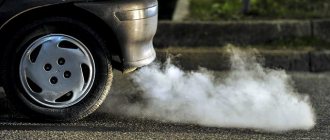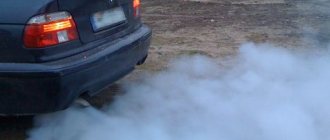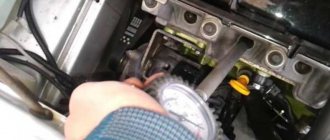The color of the exhaust gases during engine startup and during its further operation is a kind of indicator of the condition of the power unit and systems. Various problems can cause the engine to smoke white, black, blue or bluish exhaust. As a rule, with a working engine, drivers briefly observe only white smoke when starting a diesel engine or gasoline internal combustion engine.
We also recommend reading the article about what can knock, whistle or grind in the engine and engine compartment when starting the engine. From this article you will learn about the main possible reasons for the appearance of extraneous noises and sounds under the hood.
Note that this phenomenon in some cases is not a malfunction, especially when the indicated smoke formation after warming up the internal combustion engine becomes less intense or disappears completely. If blue smoke comes out when starting the engine or the driver notices black smoke when starting a cold engine, then this is a reason to check the power unit.
In this article we will talk about the reasons why black smoke may appear when starting the engine in cold weather, what blue smoke indicates when starting a cold engine, and also why white smoke comes out when starting the engine.
What does black smoke mean from the exhaust pipe of a gasoline engine?
Car muffler emissions poison the environment - this is a problem on a global scale. Manufacturers, caring about the environment, strive to purify exhaust to combine nitrogen with carbon dioxide and water vapor.
The ideal option is only possible if the power unit, ignition, fuel supply or cooling systems are in good working order. Black smoke from the exhaust pipe of a gasoline engine indicates a breakdown of the engine or auxiliary modules. Therefore, the appearance of a symptom requires inspection and repair of the vehicle’s chassis components.
Soot from a pipe in a carburetor car
Let's move on to a car with a carburetor power system, an example would be the VAZ-2106 model.
When starting the engine of this car, black smoke should not be observed, but white smoke is a normal phenomenon, but in some situations it is also unsafe.
If black exhaust gases come out of the pipe, this is the first sign that the carburetor adjustments have been disturbed, in particular, the position of the quantity and quality screws is off.
Because of this, the carburetor doses more fuel than necessary.
Again, the cause may be a clogged air filter, however, on carburetor systems this will be more of an additional problem.
Wear of the cylinder-piston group is one of the most common causes of black exhaust gases. When worn out, oil enters the cylinders - hence the smoke.
Impaired valve timing in a late-ignition heap can also be a source of the problem.
Why is there black smoke coming from the exhaust pipe?
In properly tuned internal combustion engine cylinders, the air-fuel mixture burns out completely. When black smoke comes out of the exhaust pipe of a gasoline engine, this means that soot has appeared in the emissions - dense particles of unburned hydrocarbons. Soot is clearly visible on freshly fallen snow and the walls of the exhaust tract.
At high speeds
The appearance of coal-dark smoke on a warm engine is associated with an over-enriched fuel mixture in the combustion chambers. The first to come under suspicion is the air filter (AF), which loses its capacity due to accumulated dirt.
Black smoke from the exhaust pipe on gasoline at high speeds also appears due to a faulty fuel pump. It would be useful to check the ignition system and oxygen sensor - lambda probe.
Intense black smoke
When starting the car
When the engine is warming up, especially in cold weather, small clouds from the exhaust tract should not cause alarm: the proportion of air and gasoline in the working mixture for the cylinders has not yet been restored. And the fuel does not have time to burn, settling into flakes of soot.
But if a short-term phenomenon does not disappear in motion, pay attention to the following elements and systems:
- valve stem seals;
- engine sensors;
- fuel quality;
- oil filter.
It is possible that the piston group parts are partially stuck.
When degassing
When you vigorously press the accelerator pedal, a sharp injection of fuel mixture occurs into the working chambers - unburned, and therefore thrown out onto the street.
Adjustments require:
- Faulty oxygen sensor.
- Fuel pump creating excessive pressure.
- Clogged with VF sediments.
On new engines, immediately after revoking the blackish mark disappears.
To preserve engine life...
Be that as it may, you should clearly know that black exhaust is dangerous not because it spoils the environment (soot flies out of the muffler and smells of gasoline), but also disrupts the normal operation of the engine, leads to increased fuel consumption and reduces the efficiency of its operation. You should always remember that particles of coked fuel not only fly out of the muffler, but also enter the piston group, becoming an abrasive and rapidly wearing out the polished (ideally, like a mirror) working surface of the liners, pistons and sealing rings.
This can lead to a noticeable drop in the service life of the engine, and instead of the required, say, according to the passport data, 500 thousand kilometers (modern cars are designed for approximately this service life) before repair, the engine will work an order of magnitude less. This is why black exhaust from an engine muffler is dangerous in the first place.
What else is worth reading
Heating the oil in the crankcase
Exhaust system
How to clean the particulate filter
DPF temperature sensor
Causes of black smoke depending on engine type
Car engines run on gasoline (carburetor and injection designs) and diesel. The units differ in the way fuel is injected into the combustion chambers, therefore the causes of black smoke from the muffler are different.
Carburetor
The good old (and half-forgotten) carburetor is found on mopeds, motorcycles, walk-behind tractors, scooters, and Gazelles of early years of production. An important condition for the operation of a simple and reliable design with single injection is the correct stoichiometric composition. This is the ratio of fuel to air, normally 1 to 15.
But the balance can be upset due to a number of circumstances:
- debris got into the air jets;
- excess fuel appears in the float chamber;
- mechanical problems have arisen with the throttle valves;
- emulsion tubes fell out;
- the operation of the elements dispensing gasoline was disrupted.
A lean as well as a rich mixture produces poisonous black smoke from the exhaust pipe of a carburetor gasoline engine. In this case, the unit must be disassembled, washed, and repaired. To restore functionality, a simple set of plumbing tools is enough.
Black smoke at idle
Injector
In cars with a targeted supply of fuel to the cylinders (for example, Mercedes, Ford), the problem is fully present. There are many reasons for black smoke from the exhaust pipe of a fuel-injected gasoline engine. But diagnosis is complicated by the complexity of the mechanism.
Problems with injectors
Electromechanical devices are located in front of the intake valve. One of the elements of the fuel injector is the atomizer. When it wears out, fuel overflow occurs, resulting in thick black smoke pouring out of the muffler.
Faulty sensors
The injector is replete with sensors. Sensors control:
- air flow;
- engine temperature;
- crankshaft and throttle position;
- detonation and phases.
The operation of the controllers goes wrong for various reasons, then the elements transmit distorted information to the ECU. The block generates incorrect commands to the actuators: the motor begins to smoke.
Fuel pump
The gasoline pump (PG) in an injection power system is perhaps the most important component. However, the pump can create excessive pressure, although its regulator is considered quite reliable. The result of the violation will be soot emissions from the muffler.
Diesel
When a heavily loaded KamAZ smokes as it climbs the mountain, the picture surprises no one. But passenger cars, such as Volkswagen Passat, Hyundai Sonata, Kia Rio, and Niva Chevrolet, run on diesel fuel and also emit toxic combustion products. Emissions can tell a lot about the condition of a car's components.
Particulate filters
The cellular structure of diesel particulate filters traps solid particles of combustion products ranging in size from 10 nm to 1 micron. Filter elements in pairs are located behind the catalysts. Or they are built directly into the metal body of the exhaust gas neutralization device.
Particulate filters
The particulate filters contain differential pressure and temperature sensors that monitor the degree of contamination of the elements and transmit information to the engine ECU.
Clean filter elements allow only 0.1% of harmful compounds into the atmosphere. Particulate filters cannot be repaired, so if they become critically dirty, the consumables must be replaced.
High pressure pump
In the high pressure fuel pump (HPF), the speed sensor may fail or there will be a diesel fuel leak. The pressure in the pump should be 300 kg/cm2, which can be verified using the RB-4802 tester or another similar device. Water often gets into the plunger pairs of the device, then when the motor starts, the pump will jam.
A fuel injection pump malfunction is accompanied not only by a black tail at the rear of the car, but also by increased fuel consumption, engine overheating, and extraneous noise from the power plant.
Ignition timing
The air-fuel mixture in diesel engines is ignited by contact with air heated as a result of compression in the working chambers. Diesel fuel is supplied to the cylinders at a precisely calculated moment at the end of the compression stroke.
If the ignition angle is set incorrectly, fuel injection will not occur in a timely manner. A dark curtain that envelops road users will warn about inefficient combustion of diesel fuel.
Turbocharged engines
Aggregate air charging, which increases engine power with constant cylinder volumes, contributes to the occurrence of coal-colored smoke. The process is also accompanied by a characteristic whistle.
Look for and remove blockages in the air ducts, examine the intake tract and exhaust manifold: a leak may be found here.
Exhaust tract
Roar, metallic knocking, rattling from under the bottom of the car scream about breakdowns in the exhaust tract of the diesel internal combustion engine.
Collector defects are divided into three groups:
- Mechanical, obtained when hitting obstacles or meeting curbs. Cracks appear on deformed pipes, and the fracture sites burn out.
- Corrosive, appearing from moisture, reagents, condensate. The metal parts of the exhaust tract rust and deteriorate.
- Operational, caused by natural aging processes.
When the collector has served its purpose, it will smoke when starting, accelerating and decelerating the car: solid carbon particles will not encounter obstacles in their movement onto the street.
How to get rid of black exhaust
Carburetor malfunctions...
How to deal with it? How to eliminate a malfunction in the fuel supply system and establish the process of creating an enriched combustible mixture in which air and atomized fuel would be contained in the proportions necessary for normal engine operation? In fact, you need to look for the true cause of the malfunction. As already mentioned, this could be (if we are talking about a carburetor engine) a clogged air filter that does not allow enough air into the system. Black exhaust from the muffler may be a consequence of a clogged hole in the nozzle through which air does not flow, or the reason may lie in the excessive supply of gasoline (if the float chamber is incorrectly adjusted and the fuel level in the carburetor goes off scale).
...injection and diesel...
If we are dealing with injection injection, black exhaust from the muffler may also indicate a malfunction of the fuel flow sensors (these units themselves are designed to regulate the amount of incoming air in accordance with a given norm). Or that the injectors are leaking, which, by the way, can be very relevant in the case when black exhaust from the muffler is observed when the diesel engine is running.
Although with diesel, of course, there are certain nuances. During a cold start, black exhaust will be observed in any case. Moreover, a cold start for a diesel engine is a serious test. It is not for nothing that modern cars equipped with a diesel engine always have a preheating system. But even this does not save you from exhaust emissions in the initial stages of operation of an engine running in a cold state.
What to do and how to eliminate black smoke from the exhaust pipe
A novice driver who notices black smoke from the exhaust pipe of a carburetor or injection gasoline engine should contact a car repair shop.
You can do the following yourself:
- refuel at another gas station if you doubt the quality of the fuel;
- replace fuel and air filters;
- clean the injector electronics with gasoline with special detergent additives;
- check the operation of the injectors and carburetor;
- observe the pressure in the combustion chambers, compare the data obtained with the nominal value;
- Don’t forget about diesel particulate filters: change the elements every 15-30 thousand km on the speedometer.
Watch your own driving style: extreme style with sharp starts and frequent braking at high speeds does not allow fuel to burn out effectively.
Diesel engine
So, when the diesel engine is running, black smoke comes out of the chimney. If the engine is just started, everything is fine. The power plant is not warmed up, the air enters the cylinders cold, which is why its mixing with the fuel is incomplete and some of the fuel is simply charred.
As soon as the temperature in the cylinders rises, combustion should become complete and this phenomenon will disappear.
Under significant load, a large amount of fuel is poured into the diesel cylinders, which does not always have time to burn, so the engine “smokes.” But under average loads there should be no black exhaust.
If a diesel engine constantly produces such exhaust gases, then you should look for the source of the malfunction.
Often the cause is insufficient air supply to the cylinders. Because of this, a combustible mixture over-enriched in fuel is obtained, which gives the result in the form of black smoke.
This is due to a heavily contaminated air filter.
Improper functioning of gas distribution components and mechanisms can also become a source of black exhaust gases. Impaired valve timing primarily makes it impossible to fully supply the required amount of air, hence the greatly enriched mixture.
High-quality combustion of the fuel mixture is possible only with good compression, because in this engine the mixture is ignited by compression.
Severe wear of the cylinder-piston group (CPG) can easily lead to constant smoking of the engine.
In addition, due to wear of the CPG, some of the oil will enter the combustion chambers, which will only add “soot”.
In a diesel engine, this effect can also be caused by an incorrect timing of diesel fuel injection relative to the position of the piston, the so-called fuel supply angle.
Turbocharger and causes of bluish smoke
If the car is equipped with a turbocharger, then the output of thick bluish smoke may be due to its unsatisfactory condition. As a result of a malfunction of this unit, engine oil designed to lubricate the turbine bearings leaks. The lubricant penetrates the engine starting system.
During the combustion of turbocharger oil, thick bluish smoke is formed, causing irreparable harm to the atmosphere.
To diagnose the turbine, you must perform the following steps:
- Disconnect the turbine from the engine.
- Check for oil accumulation inside the air duct.
The accumulation of large amounts of oil in the air duct and turbine is a serious defect. If you discover such a situation, you must immediately seek qualified assistance from a service center.

